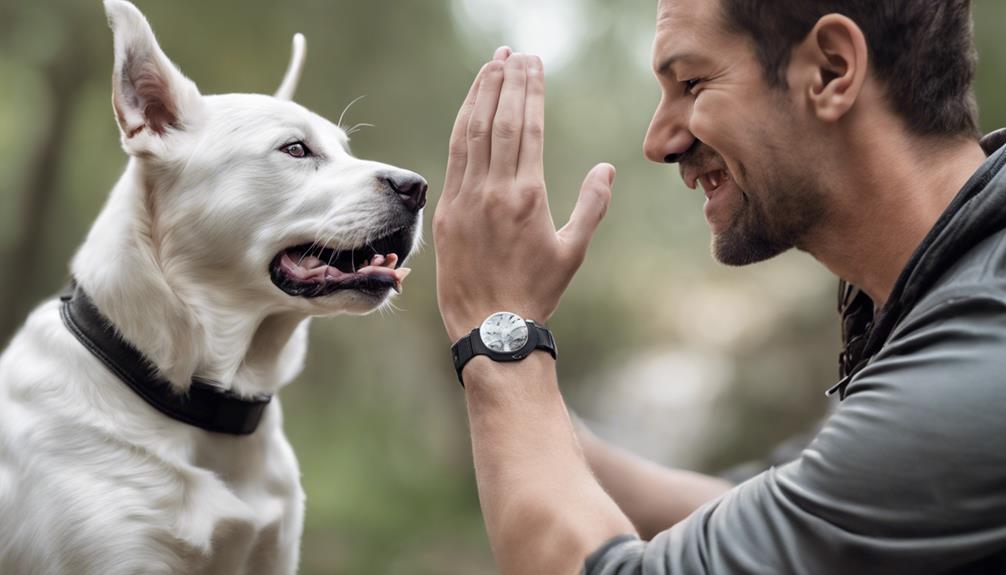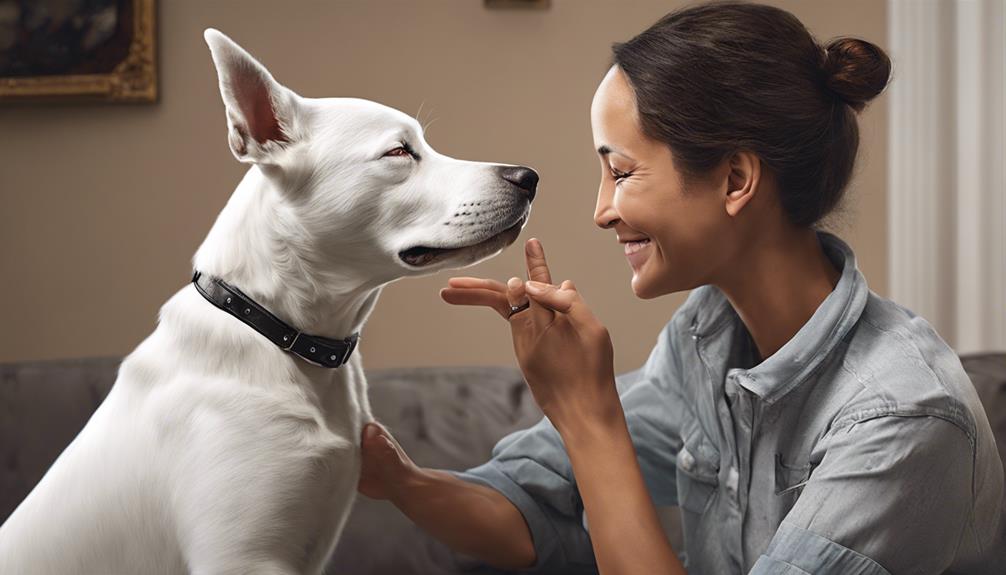As caretakers of dogs that are deaf, we frequently navigate a distinct terrain of communication and behavior. Although the challenges can appear overwhelming, grasping the root causes of behavioral issues in deaf dogs can illuminate the path to successful resolutions.
By unraveling the complexities of their world, we can unlock the secrets to fostering a harmonious relationship with our furry companions.
Key Takeaways
- Deaf dogs exhibit separation anxiety and obsessive behaviors.
- Training with visual cues and positive reinforcement is crucial.
- Effective communication relies on hand signals and visual cues.
- Seeking expert help for behavior challenges is essential.
Behavior Issues in Deaf Dogs
When living with a deaf dog, one may encounter various behavior issues that stem from their unique sensory challenges. Deaf dogs can experience separation anxiety more intensely than hearing dogs, as they heavily rely on human presence for communication and security. This reliance can lead to distress when left alone.
Additionally, due to the lack of auditory stimulation, deaf dogs are more prone to developing obsessive-compulsive behaviors such as excessive tail chasing or paw licking. Their heightened anxiety levels, stemming from struggles to comprehend their surroundings, can manifest in behaviors like pacing or increased alertness.
While deaf dogs may exhibit aggression and excitement less frequently, they often engage in more barking and licking to communicate. To help manage these behavior issues, proper training techniques that focus on visual cues, patience, and gentle touch are essential.
Signs of Canine Deafness

Deaf dogs exhibit various signs indicating their hearing loss, including inattentiveness, persistent barking, easily being startled, anxiety, and difficulty waking up. When understanding deaf dog behavior, it's crucial to recognize these signs and symptoms to provide appropriate care and training methods.
Here are some key points to consider:
- Visual Cues: Deaf dogs heavily rely on visual cues to communicate due to their inability to hear. Understanding and incorporating these cues into their training can greatly improve their communication skills.
- Specialized Training Methods: Traditional training methods may not be as effective for deaf dogs. Utilizing specialized training techniques that focus on visual signals and positive reinforcement can help in managing their behavior effectively.
- Communication Challenges: Deaf dogs may exhibit less aggression and excitement but more licking and barking as a way to communicate. Recognizing these communication patterns is essential in addressing their needs.
- Creating a Safe Environment: Deaf dogs may startle easily due to their inability to hear approaching people or other animals. Creating a safe and predictable environment can help reduce their anxiety levels and improve their overall well-being.
Common Behavior Problems Addressed
Addressing common behavior problems in deaf dogs requires understanding their unique communication needs and implementing specialized training techniques that focus on visual cues and positive reinforcement. Deaf dogs, like any other canine companions, can face challenges such as separation anxiety, OCD, and startle responses. These issues can be managed effectively through training methods tailored to their specific requirements. To help you better grasp the common behavior problems in deaf dogs, we have compiled a table outlining these challenges:
| Behavior Problem | Description |
|---|---|
| Separation Anxiety | Deaf dogs may become anxious when separated from their owners, requiring gradual desensitization. |
| OCD | Obsessive behaviors like excessive licking or tail chasing can be observed and addressed with enrichment activities. |
| Startle Responses | Sudden movements or touch can startle deaf dogs, necessitating gentle approaches and positive reinforcement training. |
| Positive Reinforcement | Rewarding desired behaviors with treats or praise can effectively shape good conduct in deaf dogs. |
| Visual Cues | Using hand signals and body language for commands can enhance communication and training outcomes. |
Understanding these behavior problems and utilizing appropriate training techniques can significantly improve the well-being of deaf dogs.
Effective Training Techniques

To effectively train deaf dogs, utilize visual cues and positive reinforcement techniques for optimal results. Deaf dogs rely heavily on visual signals and hand signals to understand commands and behaviors. Here are four key strategies for working with deaf dogs:
- Positive Reinforcement: Reward desired behaviors with treats, praise, or toys to reinforce good conduct effectively.
- Consistent Routines: Establishing consistent routines helps deaf dogs understand expectations and aids in their training progress.
- Specialized Training Methods: Tailoring training methods to suit the unique needs of deaf dogs can address behavior issues more efficiently.
- Use of Vibrations: Incorporating gentle touch and vibrations can help communicate with deaf dogs and enhance their training experience.
Socializing Your Deaf Dog
We know how important it's to socialize your deaf dog effectively.
Training with hand signals and building trust through touch are key aspects of this process.
Training With Hand Signals
Using hand signals to train and socialize your deaf dog is essential for effective communication and building a strong bond. Deaf dogs rely on visual cues to understand commands, making hand signals a valuable tool for their training.
Here are some key points to consider when training your deaf dog with hand signals:
- Visual Communication: Deaf dogs depend on visual cues for communication, making hand signals a primary method for training.
- Obedience Training: Basic commands like sit, stay, and come can be effectively taught to deaf dogs through consistent use of hand signals.
- Trust Building: Consistent use of hand signals helps establish clear communication and build trust between you and your deaf dog.
- Bond Strengthening: Socializing your deaf dog with hand signals enhances their obedience and responsiveness, creating a strong bond during training sessions.
Building Trust Through Touch
Building trust through gentle touch and positive interactions is crucial for socializing deaf dogs and fostering confidence in them. A calm approach during socialization can help alleviate anxiety and fear, leading to improved behavior in deaf dogs. Encouraging positive experiences with new stimuli can enhance their comfort in different environments. Consistent socialization efforts play a vital role in shaping a deaf dog's responsiveness and behavior towards social interactions. Properly introducing them to various situations can result in a well-adjusted pet. To illustrate further, consider the following table showcasing the impact of trust-building activities on socializing deaf dogs:
| Trust-Building Activities | Socialization Benefits | Effects on Behavior |
|---|---|---|
| Gentle touch | Increased confidence | Reduced anxiety |
| Positive interactions | Comfort in new environments | Improved responsiveness |
| Calm approach | Alleviated fear | Enhanced social behavior |
Living With a Deaf Dog

Living with a deaf dog presents unique challenges and rewards that require patience and understanding. When caring for a deaf dog, using visual cues like hand signals becomes crucial for effective communication. Incorporating tools like high-frequency dog whistles and vibrations can further aid in interacting with deaf dogs.
It's essential to approach training with care, as electronic collars may not be suitable for hearing-impaired pets. Ensuring pet safety is paramount, necessitating precautions such as supervised outings and secure yard enclosures to prevent accidents. Understanding the intricacies of deaf dog care and communication methods is key to fostering a safe and fulfilling environment for your furry companion.
- Utilize visual signals, such as hand gestures, for effective communication.
- Consider using high-frequency dog whistles and vibrations to aid interactions.
- Approach training with caution, avoiding potentially harmful tools like electronic collars.
- Prioritize pet safety by supervising outings and securing the yard to prevent accidents.
Seeking Professional Assistance

Navigating behavior challenges with a deaf dog can be complex, and seeking professional assistance from certified trainers and behaviorists can provide tailored guidance and support. When dealing with deaf dog behavior problems, it's crucial to enlist the help of experts who understand the unique needs of these special animals. Certified dog trainers and behaviorists offer specialized assistance in addressing behavior issues specific to deaf dogs. Organizations like CCPDT or IAABC can provide valuable insights and support to tackle these challenges effectively. Additionally, online forums and dedicated websites on deaf dog behavior can offer additional resources and information for pet owners seeking guidance.
To help you visualize the benefits of seeking professional help, consider the table below:
| Resource | Description | Benefits |
|---|---|---|
| Certified Trainers | Provide specialized deaf dog training programs tailored to address behavior challenges | Expert guidance and structured training |
| Behaviorists | Offer in-depth behavior assessments and customized behavior modification plans | Professional support in behavior management |
| Online Forums | Community-driven platforms where deaf dog owners share experiences, tips, and advice | Access to a wealth of shared knowledge |
| Deaf Dog Training Classes | Structured classes focusing on deaf dog training techniques to address specific behavior issues | Hands-on learning and skill development |
Frequently Asked Questions
How Do You Discipline a Deaf Dog?
When disciplining a deaf dog, we focus on positive reinforcement techniques. Physical punishment is avoided to prevent fear and build trust. Time-outs are used to correct inappropriate behavior.
Consistency and patience are crucial to set clear boundaries. Seeking professional guidance or joining support groups can provide effective strategies.
How Do You Get a Deaf Dog's Attention?
We gently touch or use vibrations to get a deaf dog's attention without startling them. Visual cues like hand signals or flashing lights effectively communicate with them. Avoid sudden movements and incorporate positive reinforcement techniques for training.
Consistency in communication methods is key. By following these strategies, we can successfully grab a deaf dog's attention.
How Do You Wake up a Deaf Dog Without Scaring Them?
When waking up a deaf dog, it's crucial to be gentle to avoid triggering anxiety or fear. We can gently blow on their bum, lay a hand on their shoulder, or stomp our feet to create vibrations. These non-verbal cues are vital for communication with deaf dogs.
Establishing a predictable and calm routine for waking them up can help reduce stress and anxiety, ensuring a positive start to their day.
Can Deaf Dogs Be Happy?
Deaf dogs can absolutely be happy! With proper training and care, they can lead fulfilling lives. Visual cues and specialized training methods are key to their happiness.
Patience and adjusted communication methods play a crucial role in helping them thrive. Creating a safe environment is essential for their well-being. Deaf dogs may exhibit different behaviors, but with the right approach, they can be just as joyful as any other dog.
Conclusion
In conclusion, navigating the world of deaf dog behavior problems can be a challenging yet rewarding experience.
By understanding their unique communication needs and utilizing specialized training techniques, we can help our furry friends thrive.
Remember, patience and positive reinforcement are key in addressing any issues that may arise.
So, grab those treats, put on your training hat, and show your deaf dog some love – they'll appreciate it more than you know.











